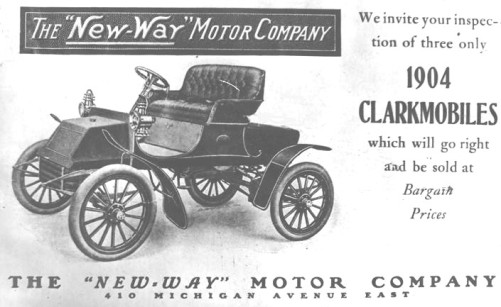Clark & Company of Lansing Michigan built the body for R.E. Olds first gasoline-engined car in 1896 and later went on to manufacture the Clarkmobile car in 1903-1904.
Originally was known as the Clark Power Wagon Co. founded by carriage maker, Albert Clark at 231 S. Grand - Lansing, MI
Clark & Co. was a carriage manufacturer in 1896 they produced 3,000 carriages, buggies and cutter a year at it's peak. In 1897 the depression slowed them down and they only employed 50 men. In 1902 a short-lived gas-powered horseless carriage company was founded by Frank Clark & Arthur Stebbins and Harris Thomas. They were the first producers of the first body for R.E. Olds' gasoline-engine horseless carriage. In 1905, they manufactured the Clark Mobile. In 1913, the company employed 100 men.
Frank Clark manufactured carriages with his father Albert in the late 1800s. In 1902 Frank Clark and William Newbrough organized the Clarkmobile Co. and introduced his first automobile in 1903.
In 1905 Frank Clark sold his business to New Way Motor Co. In 1910 Frank G. Clark organized Clark & Co. to produce the Clark Automobile.
Frank G. Clark's father Albert was never in favor of the automobile. So Frank waited until after his death in the early 1900s to begin automobile production. The Clark & Company Carriage Manufacturers reportly built the body for the first test car produced by Ransom E. Olds in 1896.
The Clark automobile was a three passenger high wheeler with solid rubber tires and wheel steering. The Clark was equipped with an opposed two cylinder air cooled engine that developed 14 horsepower.
The Clark Automobile was only produced in 1910 and 1911, the company failed and went out of business. Frank Clark then went into the production of trucks.
Clarkmobile
Clarkmobile was an automobile first built in 1902 by Frank Clark of Clark & Company in Lansing, Michigan. The first model became available in 1903. A newspaper article referred to the automobile as the 'Unbreakable Clarkmobile' and showed it surviving an accident.
Before the Clarkmobile, Clark & Company Carriage Works built the body for the first test car produced by Ransom E. Olds.
Production ceased in 1904. The Deere-Clark company purchased the company's tools and machinery. Frank Clark went on to make the Clark car in Shelbyville, Indiana.
Features
The Clarkmobile included a number of innovative features such as wheel steering, shaft drive, a front end with hood, and a new engine design.
The $750.00 Clarkmobile was equipped with a self starting single cylinder horizontal four cycle engine with a 5 inch bore rated at 7 horsepower. The speed of the engine was controlled by foot lever which allowed a speed of 5 to 30 miles per hour. Transmission was made by Upton and had two speeds forward and reverse. Final drive was by a single chain.
Other features of the Clarkmobile included a standard tread, 72 inch wheelbase, leather seats, wood artillery wheels, iron hubs, Dunlap tires, wheel steering, Brown and Lipe steering gears and double acting brakes.
In 1905 Frank G. Clark sold The Clarkmobile Company and went on to produce the Clark Automobile from 1910 to 1912. The Clarkmobile Company was then reorganized into The New-Way Motor Company. A. C. Stebbins was president, J. W. Knapp vice-president and William H. Newbrough was treasurer, E. W. Goodnow secretary and finally Charles H. Way was a mechanical engineer. The New-Way Motor Company was name after William H. Newbrough and Charles H. Way. The real driving force behind the New-Way Motor Company was William H. Newbrough and Charles Way. Fire destroyed much of the New-Way Motor Co. factory on July 3, 1906.
The New Way Motor Company produced an air cooled engine that was designed by Charles Way. The company then used the old Clarkmobile chassis and fitted it with the new engine. The Clarkmobile Company transferred its patents and other properties to New Way Motor in 1905. The New Way Motor Company produced Clarkmobile automobiles until 1907. It then produced a engine that was used in agricultural and marine use for many years.








